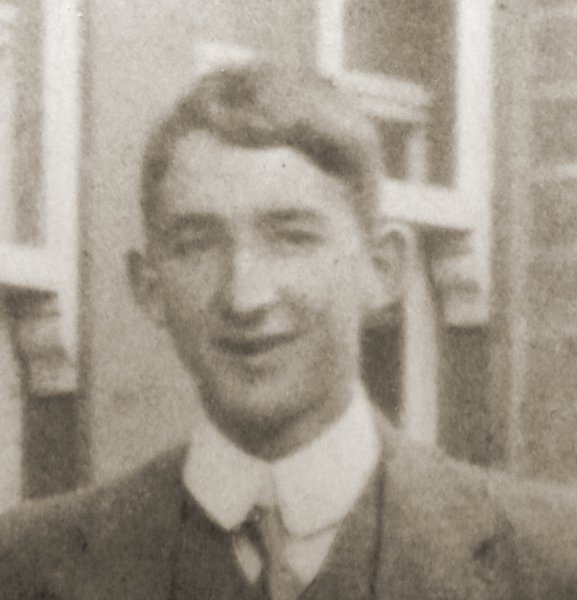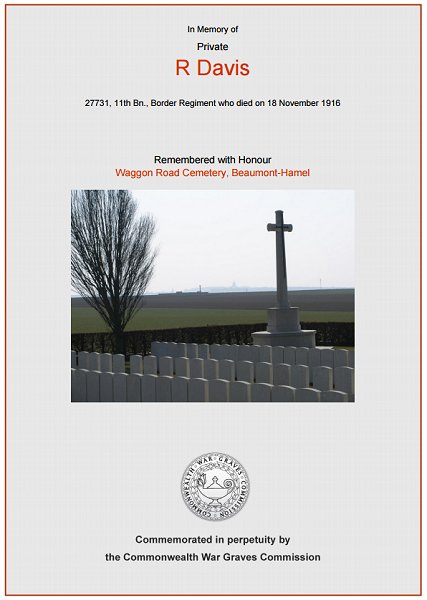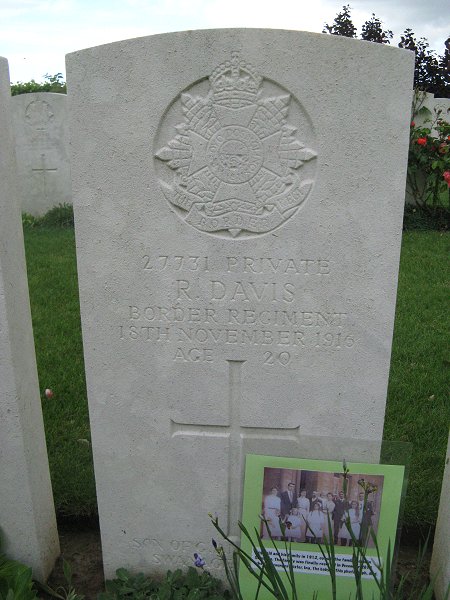yeovil at War
Reginald Richard Davis
Killed in action during the Battle of the Ancre
 Reginald Richard
Davis was born
in Yeovil on 8
May 1896, the
son of
journeyman
plumber George
Jacob Davis
(1866-1952),
originally from
Brisbane,
Queensland,
Australia (of
English parents), and
Jessie Louisa
née Glass
(1870-1950),
originally from
Upton Hellions,
ten miles
northwest of
Exeter, Devon. George and
Jessie were
married in
Exeter in 1888
where they
initially lived.
Their first
three children
were all born in
Exeter; Emma
Louisa (b1889),
Florence Mary
(b1891) and
James S (b
1892).
Reginald Richard
Davis was born
in Yeovil on 8
May 1896, the
son of
journeyman
plumber George
Jacob Davis
(1866-1952),
originally from
Brisbane,
Queensland,
Australia (of
English parents), and
Jessie Louisa
née Glass
(1870-1950),
originally from
Upton Hellions,
ten miles
northwest of
Exeter, Devon. George and
Jessie were
married in
Exeter in 1888
where they
initially lived.
Their first
three children
were all born in
Exeter; Emma
Louisa (b1889),
Florence Mary
(b1891) and
James S (b
1892).
The family then moved to Yeovil where their son George Clifford was born in 1895, followed by Reginald in 1896. However by 1901 the family had left Yeovil and moved to Swanage, Dorset where their later children were all born; Freda Jessie (b1902), Audrey Kathleen (b1907), Phyllis Joyce (b1908) and Ina Gertrude (1910-2013).
The move to Swanage is, of course, the reason Reginald's name is not included on Yeovil's War Memorial in the Borough.
In the 1901 census the family were listed at 1 Albany Terrace, Swanage, and in the 1911 census they were listed at 2 Albany Terrace. In this census 14-year old Reginald gave his occupation as an 'Odd Boy'.
It is not known when Reginald enlisted, but he enlisted at Tredegar, Monmouthshire, joining the 3rd/1st Battalion, Hereford Regiment. His Service Number 4255 suggesting an enlistment during the summer of 1915. At the time of his enlistment his address was given as Sirhowy, Monmouthshire.
In June 1916 Reginald married Edith Clara Preece at Hereford. Reginald's great niece Barbara Davis said "Family tradition has always said that Reginald had died aged 20 but had been married twice.... the pay owed to Reginald at his death was sent to his widow Edith Clara. We can't find out what happened to his wife but we do know that she didn't inform the Davis family of his death. The family found more details from the War Office in the 1920s.... a possible first wife was named Sarah Catherine, with whom Reginald probably lived in Sirhowy."
On 22 September 1916 some 250 men of the Hereford Regiment, including Reginald, were transferred to the King's Shropshire Light Infantry. His new Service Number was 20460.
However, after being posted overseas on 1 October 1916 these reinforcements, including Reginald, were transferred to the 11th (Service) Battalion (Lonsdale), Border Regiment on 11 October 1916. His new Service Number was 27731.
The 11th Battalion had been formed in Penrith by Hugh Lowther, the 5th Earl of Lonsdale in September 1914 and landed at Boulogne on 23 November 1915. Nearly all the men came from Cumberland and Westmorland and it was one of the many so-called “Pals” Battalions and wore a distinctive silver cap badge of a winged griffin from the Lowther coat-of-arms, shown above. The Battalion fought on the opening day of the Battle of Somme on 1 July 1916 and suffered over 500 casualties out of the 800 men who went into action, including 23 out of the 26 officers. It was as a result of this decimation that Reginald was among the number of troops transferred to the 11th Battalion, Border Regiment on 11 October 1916 to reinforce its numbers.
The battalion fought in the Somme Offensive throughout the summer and autumn of 1916.
The 11th battalion fought in the Battle of the Ancre from 13 to 18 November 1916. This was the final large British attack of the Battle of the Somme in 1916. It involved an attack on the German front line as it crossed the Ancre River, a sector of the front that had first been attacked by the British, including the 11th Border Regiment, on the first day of the Battle of the Somme without success. This was a strong sector of the German front. The first British objective involved an advance of 800 yards and would require the capture of at least three lines of trenches. The next target was the German second line, from Serre south to the Ancre. Finally it was hoped to capture Beaucourt, on the Ancre. All the early successes on the Ancre achieved was the creation of a British held salient on the Ancre, which proved to be a very dangerous area to be posted over the winter of 1916-17.
On 18 November 1916, the official last day of the Somme Offensive, the British tried to capture Serre by taking Soden Redoubt to the south and early on had success in confused fighting. The British attack got forward 600 yards (550m) beyond Beaucourt, despite many casualties caused by massed German machine-gun fire and local counter-attacks. Reginald was killed this day as he went into battle at 6:10am. He was just 20 years old.
Reginald was buried at Waggon Road cemetery, Beaumont-Hamel. Grave C7. His name is recorded on the Swanage War Memorial. His name was added to the War Memorial in the Borough in 2018.
Many thanks to Reginald's great niece, Barbara Davis, for supplying much of the above information.
gallery

Courtesy of
Barbara Davis
Reginald Richard Davis, aged 16, in an enlargement of the photograph below.

Courtesy of
Barbara Davis
The Davis family outside their house in Swanage, Dorset, in a colourised photograph of 1912. Reginald is third from right.

The Commonwealth War Graves Commission certificate in memory of Reginald Davis.

Reginald's Commonwealth War Graves Commission headstone at Waggon Road cemetery.